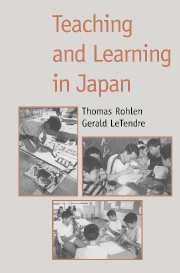Book contents
- Frontmatter
- Contents
- List of contributors
- Introduction: Japanese theories of learning
- Section I Fundamental approaches
- Teaching and learning in the Rinzai Zen monastery
- Building character
- Section II The emotional foundations of early learning
- Section III School and classroom models
- Section IV Path and guidance
- Section V Artistic pursuits – old and new
- Conclusion: themes in the Japanese culture of learning
- References
- Index
Teaching and learning in the Rinzai Zen monastery
Published online by Cambridge University Press: 05 June 2012
- Frontmatter
- Contents
- List of contributors
- Introduction: Japanese theories of learning
- Section I Fundamental approaches
- Teaching and learning in the Rinzai Zen monastery
- Building character
- Section II The emotional foundations of early learning
- Section III School and classroom models
- Section IV Path and guidance
- Section V Artistic pursuits – old and new
- Conclusion: themes in the Japanese culture of learning
- References
- Index
Summary
Popular images of Japan tend to cluster around two conflicting cultural stereotypes. One depicts Japan as a ritualistic, rulegoverned, hierarchical society where obsession with preserving traditional form and with conformity to group goals stifles individual creativity. The other pictures Japan as the repository of a mystical culture that produces gentle, creative, slightly foolish sages. These two stereotypes clash. How can one society be both? A closer look at teaching and learning in the Japanese Zen monastery allows us to see how ritual formalism coexists with mystical insight.
I propose to divide the spectrum of human learning into three domains: (i) ritual formalism, (2) rational teaching and learning, and (3) mystical insight. In modern Western society, we have focused upon, and greatly developed, what I have labeled rational teaching and learning, but we seem to have less interest in, or confidence about, the two ends of the spectrum. A Japanese Zen monastery, on the other hand, substantially discounts rational teaching and learning and teaches both ritual formalism and mystical insight. In fact, it teaches mystical insight by means of ritual formalism.
- Type
- Chapter
- Information
- Teaching and Learning in Japan , pp. 20 - 49Publisher: Cambridge University PressPrint publication year: 1996
- 1
- Cited by



